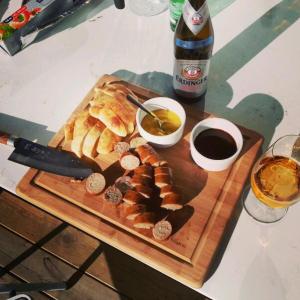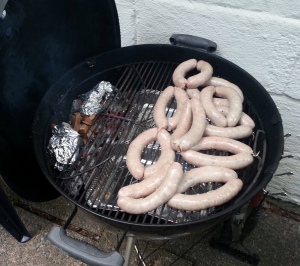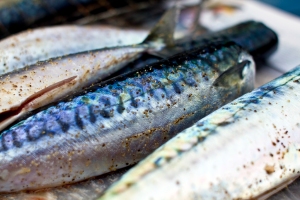
Homemade coleslaw and pulled pork sandwich. Ah yeh…
Pork butt is a fantastic piece of meat. It’s quite a tough cut, with a lot of collagen (and fat), which makes it perfect for low and slow BBQ. If you can’t get pork butt where you live, you can try a boned-out ham. However, the best cut for this is the pork butt which is essentially the upper part of the pork shoulder ham cut, here in Norway not a regular cut, but when I tell my butcher I want the upper part of the ham, basically the shoulder-blade, with all the meat and fat on it, I get the right thing. Keeping the bone in there helps the meat become more juicy because the bones contains gelatine, so I always get bone-in when I can. Gives you that lip-smacking goodness feel you get from good ribs. Guess that’s why gelatine is used a lot for making candy, huh… That goes for any meat – bone-in = better. Talk to your butcher and show him some charts and google images, and I’m sure you’ll get it right. Now, to get a historical fact out of the way, they’re not called butts because they’re from the butt (because they’re from the shoulder end of the pig really..), but because this cut was stored in special barrels known as butts, in the olden days. Read more on Wikipedia.

Pork butts ready for pullin’
This is not a good place to start for the novice griller, but if you think you’ve got indirect grilling and temperature control on your kettle or smoker down, you should try it. Pork butt is some of the best eats to ever come out of a BBQ, and it’s a cheap cut, which enables you to feed tons of people for little money. Time for a party, in other words. Let’s get to it.
Serving suggestion:
I serve this dish in a very traditional manner, on homemade hamburger buns, with a creamy coleslaw, a basic Eastern North Carolina style vinegar sauce, and some pickled gherkins. Don’t make it complicated, the meat should be the star.
Total time: 10-14 hours (prep starts the day before)
Skill level: Intermediate/Expert
Grilling method: Indirect, one-zone (some coals on one side, large drip pan filled with water under the meat)
Grill temperature: About 120-140 degrees centigrade (250-285F)
You’re going to need:
- Time, I usually start around 6-7 AM when I do this and we eat around 7-8 PM. A great excuse to drink beer and “mind the bbq” all day, in other words. Kinda like fishing or golf in that regard (dads will know what I mean…)
- 2 pork butts (I always make two, because that’s what I have room for on my kettle. Pulled pork freezes well, so if I have leftovers, that just means my wife is going to be happy for the next few weeks eating pulled pork sandwiches..)
- 1 cup of your favourite all-round spice rub
- Some yellow American mustard (to be used as a glue)
- 1-2 bags of charcoal briquettes (make sure you get good ones with no chemicals and food starch as a binder)
- 4-5 cups of wood smoking chips (I like to mix hickory and some mesquite for pulled pork, read more about smoke wood here. Apple wood is also great)
- A notebook and a pen, for taking notes during the process
- An instant-read thermometer like a Thermapen, or a leave-in probe style thermometer

Pork butt, rubbed and ready to go
How you do it, the night before:
- Prep should ideally start the day before. Cut the skin off the butts unless your butcher did it, but leave a good thick layer of fat on the meat
- Lay out some lengths of plastic wrap on your workspace, and put a pork butt on there. Put a thin layer of yellow mustard on it, and apply generous amounts of spice rub all around it. I use about 0.5 cup for each butt
- Wrap in several layers of plastic wrap, and repeat.
- I store my butts overnight in the fridge. It’s (almost) always a good idea to room temper your meat before it goes on the grill, as long as you’re able to do it in a safe, hygienic manner. However, if you want to maximize your smoke penetration and smoke ring size, you should go straight from the fridge on this one. Experienced BBQ’ers tell me the smoke ring only happens when the meat is below 60 degrees centigrade (140F)
How you do it, cooking day:
-

Taking notes is paramount if you want to learn
Fire up your chimney starter with 20 briquettes (this is based on my 22.5″ Weber kettle, and your mileage and/or method may vary on other grills and smokers)
- In the meantime, put a briquette basket on one side of the grill only, and a big water pan covering the whole middle part of the grill. Why water you say? The mass of water (I use a stainless steel pan from Ikea that holds about 4-5 liters or one US gallon) helps me maintain a steady temperature inside the kettle, because water stores (in this case) heat pretty well. It also helps the meat retain its moisture during the long cook by increasing the general moisture in the cooking environment.
- When your briquettes are white hot, put them in the briquette basket you put on the one side of the grill.
- Put two smokebombs (a handful of soaked wood chips wrapped in aluminium foil) on the briquettes. Putting them out towards the edge of the fire makes them last longer. Wait 5-10 minutes until they start smoking. Replace these as often as you please once they are smoked out. This is especially important the first 4 hours, after that the meat won’t really soak up the smoky flavours anymore.
- Put the grate on, pork butts on the grate away from the fire, and put the lid on
- Next is 10-12 hours of temperature watch. You should try to adjust your temperature using only the bottom vent(s) on your grill. The top one should stay at least 50% open. If you close the top one too much, you can get a soot buildup, which will not taste nice.
- Eventually, usually after 4-6 hours you may run into something BBQ’ers call “the stall” – The temp of the pork butt will stabilize or plateau at about 68-70 degrees C (154-158F) – sometimes it will even drop a little. This can go on for hours and really f up your dinner schedule. Read up on the stall in this great article, it’s got useful, common sense information you need to be aware of if you do low and slow.
- A lot can be said on how to do this on a kettle style grill, but it should be possible. However, there are a lot of factors that come into play when doing a long cook on a kettle or smoke. Wind. Rain. Sun. Shade. Air temperature. Humidity. Which is what makes this fun, and exciting, and a skill that is learned from experience.
- If it gets too hot, I take my tongs and dump a briquette or two right in the water pan. You can take them out too of course, just don’t put them on your wooden deck…
- If it gets too cold, you might need more briquettes. I put in 6-8 unlit briquettes every hour when I do this. If you get a strange dip in temp and really need to knock it up quickly, you can use unsoaked wood chips or chunks, or you can put on some lump charcoal which burns a lot hotter than briquettes. Just be patient and don’t overdo it.
- I will not go on in lengths on all the different ways to get there, you shold keep a log of times, kettle lid temp and meat temp, so you’ll have something to learn from for your next cook. The important part is to have fun, and reach a target temp of about 87-90 degrees centigrade (that’s 190-195F). The other important part, is to get there slowly.
- If you get to the target temp too early, don’t worry. Wrap the meat in aluminium foil, and a couple of kitchen towels, and put it all in a cooler, and it will stay warm enough for hours.
- When you’re ready to serve, it’s time to pull the pork. If you did everything right, it

Two butts, a ham and a cow chest
should be easily pullable by hand. Here’s a neat tip, get some thin carpenter’s gloves from your local hardware store, and buy some vinyl gloves one size up at the supermarket. Put the builder’s gloves on first and then the vinyl gloves (duh!), and you will be able to pull two pork butts without burning off your fingers (I’ve tried, not fun). If it’s not easy to pull by hand, you took it off the grill prematurely. Don’t worry, use a knife to assist you, it should still taste great. If it does not taste great, you have failed, and consequently brought shame upon your house and family.
- Once all the pork is pulled, drench it in the North Carolina style vinegar sauce, and serve. Enjoy the taste of a fantastic dish, knowing it tastes even better for you, because you’ve been outside working the BBQ all day. NICE!



























































